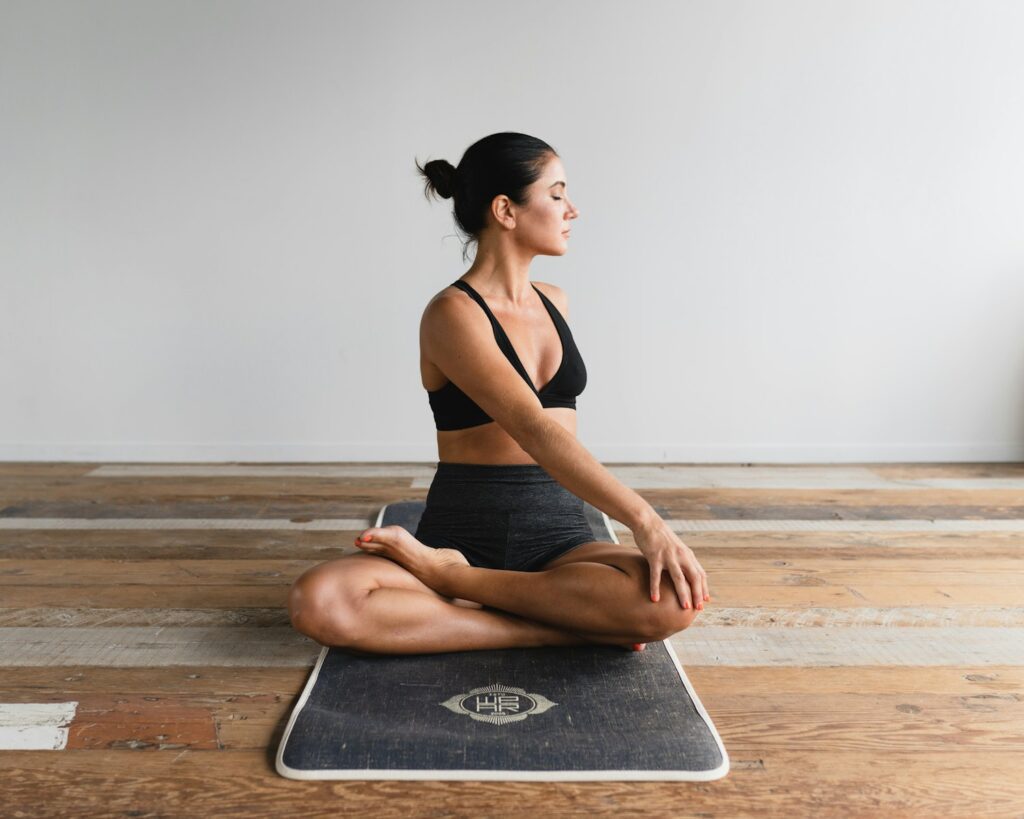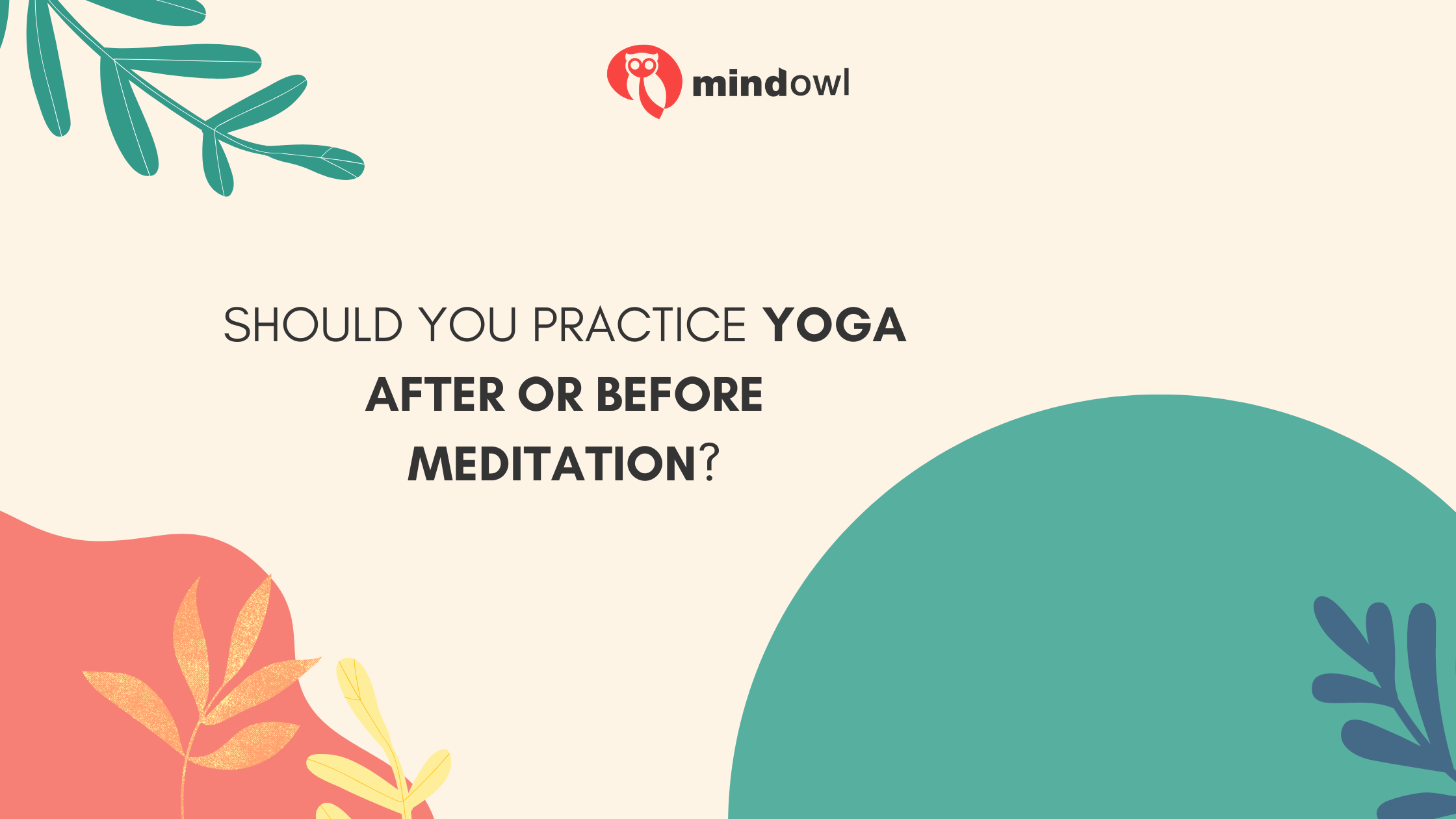Deciding whether to meditate before or after yoga can be a bit confusing. You might wonder, “Which order will give me the best results?” Well, you’re not alone in this quest for balance between stillness and movement.
In this article, we’ll help you find that sweet spot when integrating meditation with your yoga routine. Whether you lean towards starting with asanas (yoga poses) or sitting quietly first thing in the morning, we’ve got you covered.
Key Takeaways
- Yoga and meditation both help make your mind and body work together better.
- Meditating before doing yoga can calm your mind.
- After yoga, meditating lets your body cool down and feel thanks for the workout.
- Choosing when to meditate depends on what feels right for you.
- Using guided meditations can help focus your mind, especially if sitting still is hard.

Understanding the Link Between Yoga and Meditation
Yoga and meditation share a fundamental principle: recognising the interconnectedness between the mind and the body. Yoga asanas (postures) and pranayama (breath control) are designed to prepare the body and mind for meditation by cultivating physical strength, flexibility, and mental focus
While yoga incorporates physical movements and postures, meditation involves stillness and inner exploration. However, these practices are not mutually exclusive; they complement and enhance each other.
During a yoga session, practitioners often transition from dynamic asanas to a final resting pose called Savasana, which is a form of meditation itself. This integration of movement and stillness allows practitioners to experience the benefits of both practices within a single session.
Conversely, many meditation techniques involve focusing on the breath or body sensations, which are also central to yoga practice. This shared emphasis on breath awareness and mindfulness creates a seamless integration between the two disciplines.
The Advantages of Meditating Before Yoga
- Cultivates Focus and Presence
Meditating before yoga can help quiet the mind and increase your focus and presence on the mat. By stilling the mental chatter through meditation, you’ll be better able to stay grounded in the physical sensations of each yoga pose rather than getting distracted by thoughts12. This heightened awareness allows you to move with greater mindfulness and get more out of your practice.
- Reduces Stress and Anxiety
Meditation is well-known for its stress and anxiety-reducing benefits. Taking a few minutes to meditate before yoga can lower your levels of stress hormones like cortisol3. This calmer state prepares your mind and body to approach physical practice with less tension and more ease. You’ll be able to breathe deeper and move with more relaxation.
- Improves Mind-Body Connection
One of the core principles of yoga is the union of mind and body. Meditating first can enhance your awareness of this connection. As you transition from the stillness of meditation to the movement of yoga, you’ll be more attuned to the interplay between your mental state and physical being. This integration deepens the experience.
- Prepares for Focused Breathing
Controlled breathing (pranayama) is a key component of yoga that requires concentration. By first settling the mind through meditation, you’ll find it easier to maintain your focus on the breath during the yoga poses. The breath awareness cultivated in meditation naturally carries over into the yoga practice.
- Increases Body Awareness
Meditating can make you more conscious of physical sensations in the body. This heightened proprioception can help you move into yoga poses with greater care and alignment to avoid injury. You’ll be more in tune with your body’s limitations and capabilities.
While meditation and yoga each offer distinct benefits, combining them can create a powerful experience of unified mind, body and breath awareness. Taking the time to meditate first can enrich your yoga practice in multiple ways

Benefits of Meditating After Yoga
- Integrates Mind and Body
Yoga prepares the body and mind for meditation through physical movement, breath work, and present-moment awareness. After a yoga session, your mind is often more settled, and your body is relaxed yet energized—an ideal state for meditation. Meditating after yoga allows you to integrate the unity of mind and body cultivated during your practice.
- Enhances Relaxation
The physical exertion of yoga can release muscle tension and promote a sense of calmness. Meditating after your yoga practice can deepen this state of relaxation. As your body is already releasing stress, meditation can further quiet the mind, creating a profound experience of stillness and tranquility.
- Increases Mental Clarity
Yoga’s combination of physical postures, controlled breathing, and present-moment focus can help clear the mind of distracting thoughts. Meditating after this mental “cleansing” can enhance your ability to concentrate and experience greater clarity during your meditation session.
- Prolongs Mindfulness
The practice of yoga encourages mindfulness—the quality of being fully present and engaged with the current moment. By meditating immediately after yoga, you can extend this state of heightened awareness and carry the mindfulness cultivated on the mat into your meditation.
- Solidifies Breathing Patterns
Yoga and meditation both emphasize the importance of controlled breathing techniques (pranayama). After practising breath regulation during your yoga session, meditation can help solidify and reinforce these healthy breathing patterns. The rhythm established through yoga can seamlessly transition into your meditation.
- Maximizes Post-Exercise Benefits
Research suggests that meditating after exercise can amplify the benefits of the physical activity. These benefits include reduced stress, improved sleep quality, and better cardiovascular health. Combining yoga and meditation maximizes these positive effects.
While yoga and meditation are individually powerful practices, sequencing them together can create a synergistic experience that enhances the mind-body connection, relaxation, clarity, and overall well-being.
Tips for Incorporating Meditation into Your Yoga Routine
- Considering Your Preferences
Everyone has different preferences and inclinations when it comes to meditation. Some may prefer guided meditations, while others find more benefit in silent, unguided practices. Experiment with various techniques, such as breath awareness, mantra repetition, or visualization, to find what resonates best with you.
Reflect on your personal goals and the specific aspects of meditation that appeal to you. Do you seek greater relaxation, improved focus, or a deeper spiritual connection? Aligning your meditation practice with your intentions can make it more meaningful and enjoyable.
- Setting Aside Time in Advance
One of the biggest challenges in establishing a consistent meditation practice is finding the time. To overcome this obstacle, it’s essential to schedule your meditation sessions in advance and treat them as important appointments.
Consider setting aside a dedicated time each day, whether it’s first thing in the morning, during your lunch break, or before bedtime. By making meditation a non-negotiable part of your routine, you’re more likely to stick to it and reap its benefits.
- Using Guided Meditations
Guided meditation can be a valuable tool, especially for beginners or those who struggle with maintaining focus during silent meditation. These meditations provide a structured framework and gentle guidance, making it easier to stay present and engaged.
Explore various guided meditation resources, such as apps, YouTube videos, or recorded sessions led by experienced teachers. Experiment with different styles and voices until you find a guide that resonates with you and helps you cultivate a deeper sense of inner calm and clarity.
Conclusion
In the end, whether you meditate before or after yoga boils down to personal preference. You can benefit from finding a balanced routine that suits your energy levels and goals. Remember, integrating both practices offers a holistic approach to wellness.
Experiment with different times to see what works best for you. Overall, listening to your body and mind is key to creating the perfect harmony between meditation and yoga in your daily practice.
FAQs
Should I meditate before or after yoga?
Meditating before yoga can help prepare your body and mind, making you less distracted during your asana practice. On the other hand, meditation after yoga allows you to relax deeply, thanks to the physical effort and release of tension.
How does meditation complement my yoga practice?
Meditation and yoga go hand in hand—like tea and biscuits! While yoga helps build strength and release physical tension, meditation quiets the mind. Together, they ensure a holistic approach to your overall physical and emotional balance.
Can I start with just a few minutes of meditation?
Absolutely! Starting with just five minutes of calming meditation either before or after your yoga session is great. It’s all about consistent practice; even a little bit every day can make a big difference.
What’s the best posture for meditating around my yoga routine?
Whether it’s seated meditation or something more contemplative like lotus pose, finding a comfortable posture where you can stay comfortably for longer is key. This helps focus better—especially if you’re adding it before stretching your body through yoga.
Is there any specific type of yoga that works best with meditation?
Kundalini Yoga—with its mix of active meditation techniques—is often recommended by many practitioners who want to integrate deep meditative practices into their routine seamlessly. However, kriya or Dharana practices also offer unique benefits when combined with regular asana sessions.
How often should I incorporate both practices into my routine for the best results?
For those ready to dive deeper, consider trying daily sessions—even if short—to see significant results in terms of quieting your mind and enhancing emotional equilibrium over time.
MindOwl Founder – My own struggles in life have led me to this path of understanding the human condition. I graduated with a bachelor’s degree in philosophy before completing a master’s degree in psychology at Regent’s University London. I then completed a postgraduate diploma in philosophical counselling before being trained in ACT (Acceptance and commitment therapy).
I’ve spent the last eight years studying the encounter of meditative practices with modern psychology.

